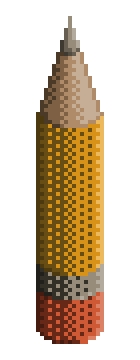Part 1 | Part 2 
PROGRAMS USED:
GraphicsGale: This is the recommended program for this tutorial as it contains tools which are ideal for pixel art and dithering.
Alternatively MS Paint, The Gimp, or Photoshop can be used.
TUTORIAL:
What is Dithering?
Dithering is a term used in pixel art to describe the technique of blending colours together. It essentially helps to add a smoother transition between two colours. For example, if we had two contrasting colours next to each other, such as orange and blue, you could easily notice the dividing line between them:![]()
However, if you were to apply Dithering in between these two colours then you would certainly notice a better transition between the contrasting colours.![]()
As you can see there is quite a difference from the first image, although you can still see some of the individual pixels. If you squint your eyes you can see that the colours merge together. This is the trick that dithering plays – it is really just a way of cheating the amount of colours you use on a piece of work, and was used a lot in the arcade games of the 1980s when computer resources were limited and when every pixel was valuable.
Why Dither?
With the powerful computer systems we have available today, the main purpose of dithering now is style. It helps to give your work that retro look. Also, if you are really conservative about saving file space, then dithering is for you. You can easily produce drawings that are only a few kb in size!! (which is ultra tiny in modern terms).
As I said, the main purpose of dithering today is to add style. It helps to show that you have thought carefully about the positioning of every pixel. Dithering can also give you additional colours to your palette and will generally give you colours somewhere in between the two colours you are merging. In the example below, I have merged red and blue together. The colours that have been produced in between are now different shades of purple. ![]()
Here’s another example of what you get when you mix blue and yellow:![]()
Yep, you guessed it. Green is produced. So what determines the colour you get? Well, it all depends on the positioning of your two colours on the colour wheel.
Now, watch what happens if you mixed two quite similar colours:
100% Zoom
Two blues close together in saturation
Two greens close together in lightness
![]()
Two oranges close together in hue
As you can see, dithering becomes most effective when the colours are close together in terms of their hue or saturation or lightness.
Part 1 | Part 2